
LIVE MOON JELLY WEBCAM
- Local Time
- Location: Georgia Aquarium, Atlanta, Georgia, USA
- Source: www.georgiaaquarium.org
-
Info: Live moon jelly webcam at the
Georgia Aquarium in Atlanta, United States.
Moon Jellyfish are distinctive with their opaque white colour. These graceful tentacled jellyfish are part of the Indo-Pacific Barrier Reef Exhibit.
View the location of the Georgia Aquarium in Atlanta, wirh Mapquest
More info: The moon jelly is found worldwide in temperate seas. It inhabits surface waters, often over reefs and along the coast.
The moon jelly is translucent and whitish in colour and often tinged with pink or blue. It has a bell shaped dome or disk that can reach 2 feet (61 cm) in diameter, with numerous short, fine, fringe-like tentacles around the margin which hang down like a veil. The four white, horseshoe-shaped structures of the moon jelly that can be seen through its translucent dome are reproductive organs. Four oral arms hang down from the center of the bottom surface of the dome.
Moon Jellyfish facts:
Video courtesy of Animal Fact Files
The moon jelly feeds on a diet primarily of zooplankton, including small shrimps, fish eggs and larvae. They catch their plankton prey using a layer of mucus over their bells before passing the microscopic meals into their mouth parts using special tentacles.
Despite not having eyes to see, or a brain to think, jellies have adaptations that allow them to orientate themselves within the water column. For example, jellies have rhopalia, which are small sensory structures. In the moon jelly, they lie in marginal indentations all around the bell. They also have specialized light-sensing structures called ocelli, and utilize statoliths, (tiny internal granules) to perceive gravity.
One defining characteristic of all jellies is that to some degree or other, they all sting. They come in all shapes colours and sizes and the Lionsmane jelly can grow to be 6-8 feet in diameter and 70 feet long. The size of the jelly is determined by the abundance of its food source. The biggest predator of jellies is other jellies. Sea anemones may eat jellyfish that drift into their range. Other predators include tunas, sharks, swordfish, sea turtles and penguins. It is possible for jellies to become a dominant species in an ecosystem where there has been overfishing and hence the removal of predators of jellie larvae. It can then become difficult to restore the previous balance.
Additional information:
Moon jellyfish animaldiversity.org
Jellyfish: The smart stinging creatures drifting through our oceans nhm.ac.uk
17 Types of Jellyfish: From Dangerous Stingers to Harmless Drifters citrusreef.com

